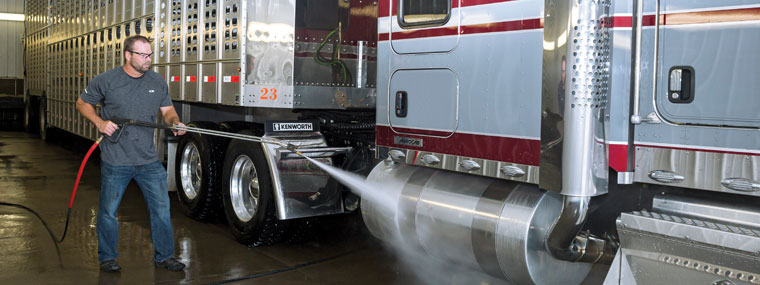
An Udder Joy
Cleaning Dairy Farms
By Diane M. Calabrese / Published September 2022

Milk, cheese, ice cream, whipped cream…all brought to us courtesy of cows. The abundant nature and popularity of dairy products should lead the enquiring pressure washer to consider if he can get into the financial action by going to the source.
More dairy farms will lead to more opportunities for those who clean them or sell equipment for cleaning milking parlors and other components…Still, there are plenty of opportunities right now.
Consider this: Milk is produced in all 50 states. That’s according to the U.S. Department of Agriculture (USDA) and includes all 50 states, which means Alaska, Hawaii, and Florida are in the mix. Surprising? Perhaps not when we include the amplification from the USDA that dairy farms are “overwhelmingly” family-owned and family-managed. The owners and managers typically belong to cooperatives.
For contractors looking to make a sale of services, getting to know members of cooperatives is a good place to start. (There’s more about cleaning expectations and regulations in the next section.)
Equipment manufacturers and dealers in our industry already sell to dairy farms. Because farms vary in size and location, tailoring equipment to the requirements of the farmer is important.
“We sell through a network of distributors, not direct,” says Karl Loeffelholz, distributor division manager at Mi-T-M Corporation in Peosta, IA. “Our hot water pressure washers and large industrial air compressors are very popular in the dairy farming industry.
“Depending on the farm, both our standard models and custom setups are used, some portable and others stationary,” continues Loeffelholz. “Our hot water pressure washers provide the cleaning power needed to blast away all the stuck-on mud, grime, milk, and feces in parlors and barns. The industrial air compressors are used to maintain and repair farm equipment as well as buildings or other projects at the farm.”
Hot water pressure washers to clean, and steam to sanitize; that’s the likely pairing when cleaning a dairy farm, says Loeffelholz.
The milking parlor area of a dairy farm is constructed to be easy to clean. Expect concrete and stainless steel to be the dominant materials, and there should be drains. The drains themselves often require cleaning, and contractors who move into dairy farm cleaning should be ready to take on the entire range of customer needs.
Alongside the objective of cleaning to remove the many kinds of soils that Loeffelholz enumerates, there’s the goal of taking the necessary precautions so that nothing tracks into a farm on the shoes or clothing of a contractor.
Conversely, contractors do not want to track home the dirt and waste they have been walking through to get to and around their cleaning target. Udder Tech Inc., a company based in Rosemount, MN, understands that. It develops products specific to the needs of dairy producers and those who support the operation of their farms.
“Our company offers waterproof gear that is great to wear while cleaning and pressure washing on dairy farms or anywhere,” says Dana Casto, business manager at the firm in the North Star State. “For pressure washing we have a specially designed jacket that keeps the water from running up your sleeves. It is our waterproof jacket with thumbhole sleeves.”
The jacket is designed to be unobtrusive. “What makes it unique is its lightweight waterproof material with thumbhole design,” explains Casto. “You put your thumb through the thumbhole sleeve and wear a nitrile glove over the top. This prevents water from getting inside the sleeve of the jackets.”
Maneuverability and maximum protection from water and residue are built into the jacket. “So, when you are pressure washing and raise your arms, the water will not get inside your sleeves and run up your arms,” explains Casto.
“Many will pair the jacket with our waterproof bibbed overalls,” says Casto. “Both items are made from the same fabric that is waterproof and can be machine wash-and-dried. This keeps you dry from head to toe. It is lightweight and comfortable to move in as well.”
Casto’s company was founded by individuals with decades-long experience in dairy products and dairy farming. Through ongoing connections with those in the dairy industry, its principals continue to get feedback on products and innovate accordingly.
The Basics
Larger dairy farms often contract with dedicated service providers that are established to clean dairy farms and help with health-maintenance checks on cows. If a dairy farm has such a provider, it’s unlikely to require services from a power washing contractor except in special circumstances.
The circumstances might be tied to cleaning building exteriors prior to a re-coating. Or perhaps a newly constructed building requires cleaning prior to the housing of animals. Because of the possibilities—rare as they are—contractors should make contact with any large service provider to a dairy farm, so the provider is aware of contractor availability if needed.
Non-porous construction materials—the concrete and stainless steel cited in the first section—make it more difficult for bacteria to grow. In the largest sense, everything on a dairy farm is about tamping down bacteria.
Bacteria can contaminate milk (yes, it’s later pasteurized, except in a few instances) and sicken cows. Bacterial infection of udders causes mastitis. When milking machines are used, they must be kept clean and disinfected to prevent the movement of bacteria from cow to cow via udders. Udders must be cleaned.
Cleaning and disinfection are linked processes on dairy farms. The housing areas for cows includes bedding that must be removed (shoveling, sweeping) before cleaning and disinfecting.
There is a lot of disinfecting on dairy farms. Busy milking parlors may be disinfected twice a day. Milking machines are cleaned at least every day. So is the milking parlor.
What about automatic, or robotic, milking parlors? They are potentially dirtier than the non-automated parlor.
Everything on a dairy farm must be cleaned. And that includes calf pens and people. Most everything also must be disinfected.
It’ not just a matter of washing hands with a disinfectant cleaner. Footwear must be disinfected. Anyone who has visited, if not worked on, a dairy farm knows about the boot baths used to disinfect boots incoming (and outgoing). The baths must be routinely changed.
The disinfection is not done to remove all bacteria, an impossible feat. It’s just done to keep bacterial numbers low enough to prevent an explosion in the bacterial population. (One trick to reduce the amount of disinfectant and changes is to use a pre-bath arrangement. A water rinse—with the water changed frequently—precedes stepping into the bath with disinfectant.)
Among the lesser things that must be cleaned on dairy farms are the foot baths. They are analogous to totes in grocery stores, as in components that must be cleaned but do not garner a lot of attention.
Dairy farms get a lot of scrutiny from state and federal regulators. Owners must routinely swab areas and monitor bacteria numbers to ascertain they are low and within acceptable parameters.
Manual cleaning methods play a significant part in cleaning on dairy farms. In addition to the cow housing areas that must be shoveled and/or swept out before washing, there are the teat cups and liners (milking clusters). If the clusters get coated with manure, the only way to remove the soiling may be to scrub with soap and water.
A good place to begin when seeking an overview of the dairy farm sector is with the USDA. The USDA “regulates and assists the U.S. dairy industry,” in its own words (https://www.ers.usda.gov/topics/animal-products/dairy.aspx). (The ‘ERS’ in the URL refers to the Economic Research Service of the USDA.)
Since 1937 when the Agricultural Marketing Agreement Act authorized Federal Milk Marketing Orders (FMMOs), the prices for milk have been heavily regulated. FMMOs are subject to modification and have been modified often, but the minimum price set points stem from them.
In the spring of 2020, many read in disbelief the reports that complications in processing milk led to milk being spread on fields or added to manure lagoons. But it did happen (another sort of supply chain issue). With the goal of not wasting milk, USDA purchased five rounds of dairy products to distribute to those whose means were more limited because of actions taken in response to the pandemic.
The complex intersection of USDA programs structured to assist dairy farmers has resulted in some large payouts to dairy farmers, such as $350 million in 2021, to shore up their finances in a volatile market. Partly because of the support, the milk production forecast in April 2022 had declined in anticipation of less milk yield per cow. In other words, some dairy farmers paused from upgrading housing for cows and incorporating new cows on their farms.
The dairy industry is fascinating. There are opportunities. And contractors who enjoy a challenge—and the chance to spend some time in rural settings—should consider the possibilities.






